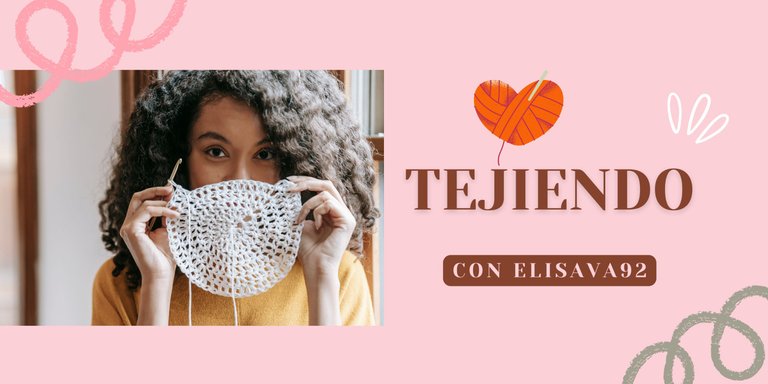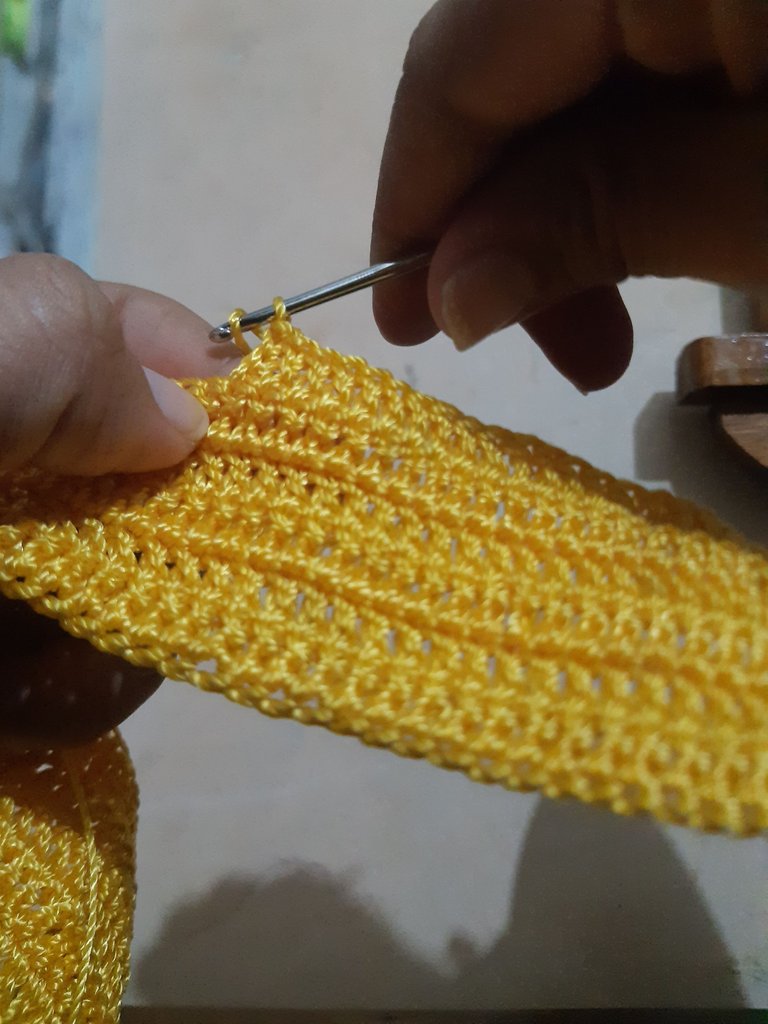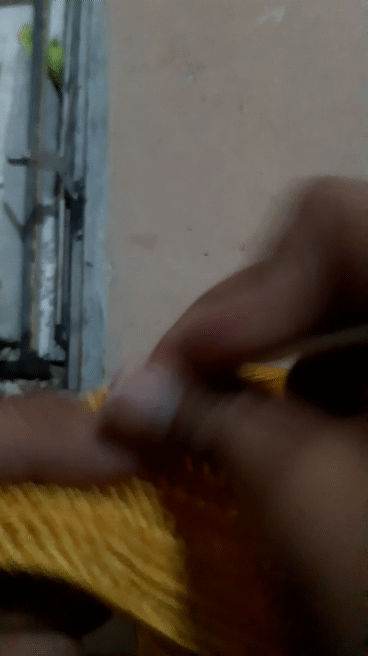
Técnica ergonómica para tejer/ Ergonomic weaving technique
Técnica ergonómica para tejer/ Ergonomic weaving technique
Hola, querida comunidad. Tengo días ausente de Hive, por diversos motivos, pero aquí retomando he decidido postear en esta comunidad por primera vez. Estoy bastante interesado en conocer los diferentes trabajos que realizan los miembros de esta comunidad. Aquí estoy totalmente a la orden en lo que pueda.
Hello, dear community. I have days absent from hive, for various reasons, but here retaking I have decided to post in this community for the first time. I am quite interested in knowing the different works that the members of this community do. Here I am fully at the order in what I can.
Mi nombre es Elisa, hace algún tiempo trabajé como profesora de tejido y bordado. Aunque nunca hice tal curso, tuve algunas personas que me enseñaron ciertas puntadas en mi infancia y de ahí Dios me ha dado el privilegio de aprender por mi cuenta. Quien me enseño a coger la aguja y el hilo fue una vecina, siempre recuerdo mi primer bolso tejido por mi, que incluso quise conservarlo hasta hace poco..... Sí, sobrevivió unos 20 años.
My name is Elisa, some time ago I worked as a knitting and embroidery teacher. Although I never did such a course, I had some people who taught me certain stitches in my childhood and from there God has given me the privilege to learn on my own. Who taught me to pick up the needle and thread was a neighbor, I always remember my first bag knitted by me, that I even wanted to keep it until recently..... Yes, it survived for about 20 years.
Pero bueno, justamente lo poco que me enseñó lo fui practicando, además de investigar al respecto. Esto me ayudó a dar con una técnica que me hiciera sentir cómoda tejiendo, sin preocuparme de complicaciones en mi cuerpo. Primero, voy a mencionar un enlace de unas tejedoras bastante activas, que en un post detallan la postura correcta que debe tener la persona al tejer. Así que te invito a leerlo:
But well, the little she taught me, I practiced it, in addition to researching on the subject. This helped me find a technique that made me feel comfortable knitting, without worrying about complications in my body. First of all, I am going to mention a link from some very active knitters, who in a post detail the correct posture a person should have when knitting. So I invite you to read it:
Ejercicios y posturas para tejer mejor
Acerca de esto, me gustaría agregar sobre el post, que a pesar de que recomienda la posición baja en los brazos, de modo que no alcen peso mientras hacen el movimiento, podría esto generar los mismos efectos que produce el uso del teléfono sobre la cervical y la aparición de la terrible papada. Por lo cual, mientras el tejido es liviano, recomiendo alzar las manos a la altura de la cara, cuando se cansen los brazos, tejer de nuevo abajo y luego volver a subir. De esa manera no tendremos rigidez en el cuerpo y,en los momentos necesarios, descansar con un buen té.
Quiero decir con lo anterior es que debemos evitar cualquier efecto contraproducente en nuestro cuerpo, el tejido es un arte, pero también sirve de terapia.
Por otra parte, la técnica que empleo para manejar mi aguja, puede que algunos ya la conozca y hasta la usen también; pero, que otras personas prefieren la de mano como conejitos porque les parece más cómoda o simplemente así aprendieron.
About this, I would like to add in the post, that although it recommends the low position in the arms, so that they do not lift weight when making the movement, this could generate the same effects that produces the use of the phone on the cervical and the appearance of the terrible double chin. Therefore, while the knitting is light, I recommend raising the hands to the height of the face, when the arms get tired, knit again downwards and then upwards. This way we will not have stiffness in the body and, when necessary, we will rest with a good tea.What I mean by the above is that we must avoid any counterproductive effect on our body, knitting is an art, but it also serves as therapy.
On the other hand, the technique I use to handle my needle, some of you may already know it and even use it too; but, other people prefer the hand needle like the bunnies because they find it more comfortable or they simply learned it that way.
Left hand: the base finger is the index finger, placing the thread on the first bend of the finger, the middle finger functions as the regulator and the thumb as the tensioner.

-Right hand:The flat part of the needle should be occupied by the thumb (at the bottom) and the index finger at the top. The middle finger acts as a pilot, it is the one that directs the whole movement of the needle. Its movements always draw an 8. While picking up thread, the thumb and index finger pull backwards. I have always liked the elegance with which this way of knitting is done.

La posición de conejito que dije anteriormente, es esta:
The bunny position I mentioned earlier, is this:

No la recomiendo, a menos que sea para trabajar con trapillo o cordón muy gruesos, cuyos tejidos no han de ser tan apretados, puesto que esta técnica es más difícil de aplicar tensión en el hilo. Otra excepción, es para momentos de descanso si sientes que la técnica anterior no te parece muy cómoda.
I do not recommend it, unless it is to work with very thick yarn or cord, whose fabrics do not have to be so tight, since this technique is more difficult to apply tension on the yarn. Another exception, is for moments of rest if you feel that the previous technique does not seem very comfortable.
Nota:
Si eres zurdo (a) aplicarías la misma técnica pero con la mano contraria. Nunca olvido una alumna zurda que al principio le costó demasiado aprender y a mí enseñarla, sentía que el cerebro se me volteaba jajaja. Hoy día teje más que yo.
If you are left-handed you would apply the same technique but with the opposite hand. I never forget a left-handed student that at the beginning it was too hard for her to learn and for me to teach her, I felt like my brain was turning over hahaha. Today she knits more than me.
Ahora espero que me cuentes tu técnica, si conoces esta y qué te
parece. Lamento que mis tomas no sean muy óptimas, mi teléfono ya no anda bien.
Me despido con un gif de como es el movimiento tejiendo. Gracias por leer.
Now I hope you tell me your technique, if you know this one and what you think of it. I'm sorry that my shots are not very good, my phone is not working well anymore.I say goodbye with a gif of how the movement is weaving. Thanks for reading.

traducción realizada con Deepl.com
Banner creado con Canva
Fotos tomadas por mi persona.
Muchas gracias. Aún no tengo Discord por la falta de memoria de mi tlf, estoy en eso, liberando memoria. Muchas gracias.
Gracias por presentarnos este maravilloso artículo, me cae de maravilla ya que he estado presentando dolencias en mis manos.
Muchas gracias y bendiciones.
Que bueno que te sirva a ti, me da mucho gusto que te guste el post. Muchas bendiciones par ti también.
Estoy fascinada con todo la información que nos ofreces, no tenía idea de que había una forma ergonómica para tejer, y después de leer de leer creo que tengo una postura inapropiada y hasta malos hábitos.
Gracias por la información.
Hola, muchísimas gracias por hacerme saber lo útil que te ha sido mi post. Me alegra que te sea de beneficio. Y pues si, es un arte que pone en funcionamiento casi todo el cuerpo aunque esté sentado, por lo cual hay que cuidar del cuerpo.
es un oficio que no e logrado aprender, gracias por tu publicacion
Hola Nahinels, pero ¿te gustaría aprender? Más adelante subiré unos post de cómo empezar a tejer.
Congratulations @elisava92! You have completed the following achievement on the Hive blockchain And have been rewarded with New badge(s)
Your next target is to reach 1500 upvotes.
You can view your badges on your board and compare yourself to others in the Ranking
If you no longer want to receive notifications, reply to this comment with the word
STOPCheck out our last posts:
Hola @elisava92, oye sí, mi hijo menor es zurdo y de pequeño me costó mucho buscar la manera de explicarle y, a él, comprender todo lo que yo hacìa con la derecha, luego entendí lo dificil que había sido para él, pero son muy inteligentes, te felicito tejer es un arte y enseñar es aún más demandante😁, éxitos👍
Gracias, amiga. Pues si, es bastante complicado, para enseñar hay que ponerse en su lugar. Me alegra que te hay gustado el post.
Practica, talento y paciencia,
Admiro a los que pueden cocer de esa forma.
Creo que en mas de una clase nos infundieron eso de en el colegio, a muchos se nos dificulto y solo lo hicimos unas 3 veces como por entregar la nota
ya que tocaba bordar en clase en precencia de la instructora.
Y si, creo que estas constumbres deberian de seguir
Ya que la gente es puro mantel plastico de forma de araña o con diversos elementos falsos impresos.
Genial tu informacion.
Tengo amigas que cosen de esta misma forma
Creo que tambien influye tener bebes para hacerles cositas de gorros y medias, XD
Gracias, Janus. Si, totalmente las tres palabras iniciales describen el arte de tejer, pero también funciona de terapia y eso lo hace más placentero. Sabes, tu mencionas que bordaste en el colegio, o no se si te refieres esta misma técnica del tejido, lo cierto es que el tejido en los hombres lo admiro. No sé, pero las puntadas le quedan tan bonitas y precisas, y generalmente son muy disciplinados con lo que se les enseña.